
Adelie penguins (Pygoscelis adeliae),
Hope Bay, Antarctic Peninsula.
Part 3. Penguins (continued)
It's wonderful to observe penguins in places like Scotia Sea
islands, where you can often see 3-4 species at the same site. Sometimes the sea
surface a far as you can see is covered with thousands of porpoising penguins.
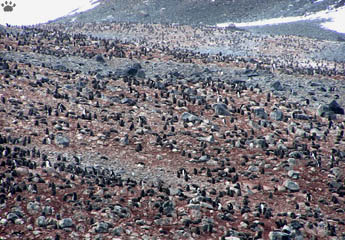
Adelie penguins colony, Hope Bay, Antarctic Peninsula. |
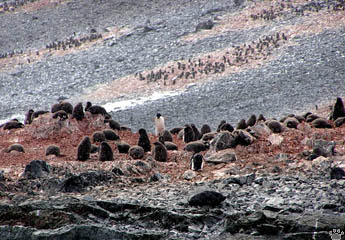
Penguin droppings are pinkish because of krill pigments. Hope
Bay. |

Adelie penguin, Hope Bay. |
In the southern part of Scotia Sea, small Adelie
penguin is the most common species. Large colonies are scattered at South Shetland,
South Sandwich, and South Orkney Islands, but the largest one in the region (well
over 100,000 pairs) is at Hope Bay at the tip of the Antarctic Peninsula. Most
are on rocky flats and slopes overlooking sheltered bays. Unfortunately, such
places are often chosen for research stations, and some colonies have already
been destroyed completely or partially. |
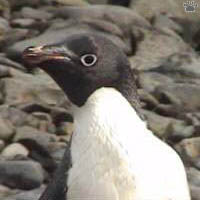
Adelie penguin, Hope Bay. |

Adelie penguin mountaineering, Hope Bay. |
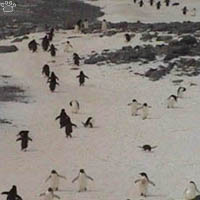
"Penguin highway", Hope Bay. |
Some colonies are a mile or more from the shore.
"Penguin highways" - well-used trails from the beach to the breeding
grounds - are always fun to watch. On snow or ice, the birds often toboggan along,
or use their beaks as icepicks. They feed in huge flocks close to shore, mostly
at night. Krill is their main food. Unlike most other penguins, they don't come
back to colony to molt, congregating instead on ice floes and small icebergs.
In winter, they migrate to the edge of pack ice. |
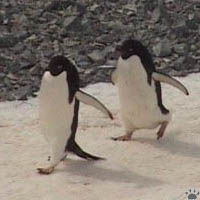
Adelie penguins on the "highway", Hope Bay. |
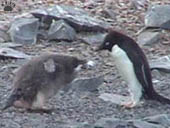 |
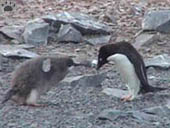 |
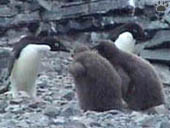 |
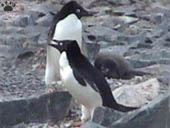 |
| Adelie penguins with chicks, Hope
Bay. |

Adelie chick, Hope Bay. |
Adelie penguins' nests are tiny pebble-laid depressions.
They lay two eggs. In late summer, you can often see pairs of chicks chasing their
parents around, demanding to be fed. Like in most other penguin species, half-grown
chicks form creches - densely packed aggregations, often enormous, where they
huddle together for warmth. Their parents somehow find them among thousands of
other chicks. |

Adelie chick, Hope Bay. |
 |
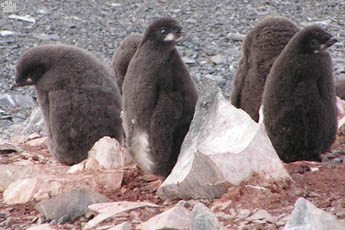 | |
Adelie penguin chicks, Hope Bay. |
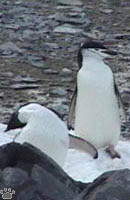
Chinstrap penguins,
Hope Bay. |
Adelie penguin is the southernmost species, common
on all coasts of the Antarctic continent. For the two related species, chinstrap
(P. antarctica) and gentoo (P. papua) penguins, the Antarctic Peninsula
is the southernmost breeding area. The bulk of chinstraps population (5 millions
out of 6.5 worldwide) breeds on South Sandwich Islands. Gentoos occur on all Scotia
Sea island groups, with around 100,000 on South Georgia, 70,000 on the Falklands,
but only a hundred on Tierra del Fuego (on Isla de los Estados). All three species
have similar habits. Gentoos tend to have smaller colonies, with large, widely
spaced nests. Northern gentoos are a different subspecies: slightly larger and
less migratory. They breed earlier and eat more fish. Chinstraps feed almost exclusively
on krill. |

Chinstrap penguins,
Hope Bay. |
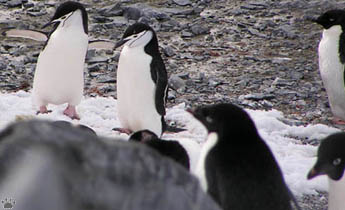
Chinstrap and Adelie penguins, Hope Bay. All three Pygoscelis
penguins sometimes
form joint colonies, but don't mix completely. |
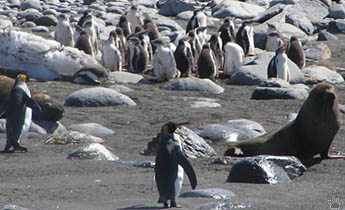
Gentoo penguin creche, with king penguins, southern elephant and
Antarctic
fur seals. Gold Harbour, South Georgia. |
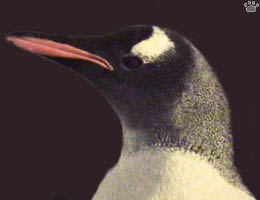
Gentoo penguin, Volunteer Cove, Falkland Islands. |
All three species can be seen on icebergs, but
Adelies use them way more often. Pygoscelis penguins are very tame, especially
chicks: often they would accept you into a creche if you slowly crawl inside.
Being hugged by dozens of warm, fluffy chicks is a great experience. |
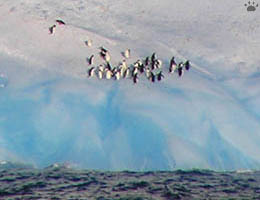
Molting Adelie penguins on an iceberg, Bransfield Strait. |
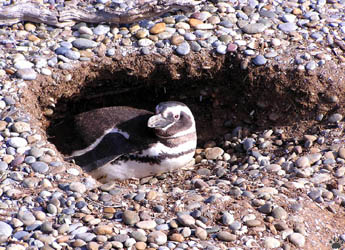
Magellanic penguin (Spheniscus magellanicus) in a burrow,
San Julian, Patagonia. |
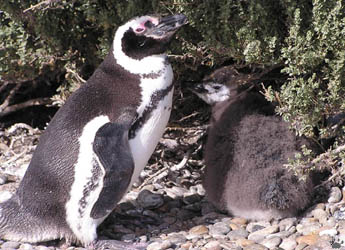
Magellanic penguin with a chick, San Julian. |
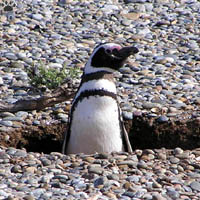
Magellanic penguin in a burrow, San Julian. |
Unlike all other breeding species of the Scotia
Sea, Magellanic penguins nest in burrows. Their colonies can be found on beaches,
sandy coasts, sometimes even in shrub thickets or coastal forests. They number
5-10 million in mainland South America, but there are also 100,000 pairs on the
Falkland, and over 600,000 at Tierra del Fuego. They seldom get far from shore,
moving north up to Brazil in winter. However, vagrant individuals have been recorded
as far as New Zealand and Australia. |
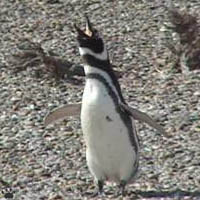
Territorial display, San Julian. |
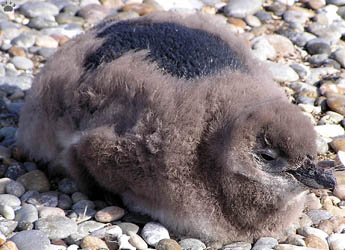 |
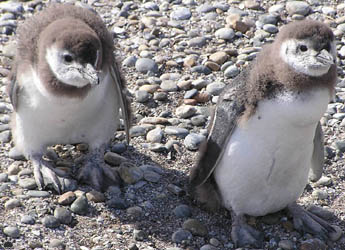 |
| Molting Magellanic penguin chicks,
San Julian. |
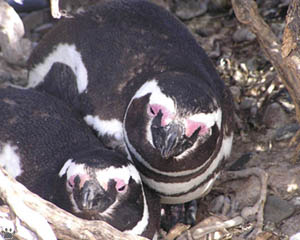
Magellanic penguins in a nesting niche, San Julian. |
Sometimes they don't excavate a burrow, but nest
in a niche made in the shade of a shrub. They start breeding in August or September,
and lay two eggs. |
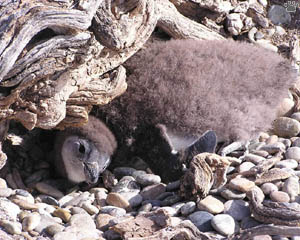
Magellanic penguin chick in a nesting niche, San Julian. |
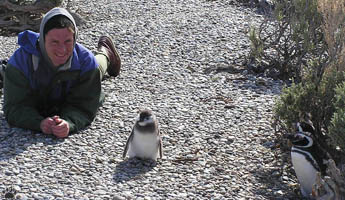
This family trusted me with watching their chick for a while. San Julian. |

Magellanic penguin creche, San Julian. |
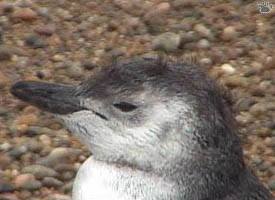
Fledging Magellanic penguin, San Julian. |
Magellanic penguins are fiercely territorial at
nests, but often engage in cooperative feeding at sea. Their main food is small
pelagic fish, sometimes squid. Their numbers are slowly decreasing, particularly
in Argentina. |
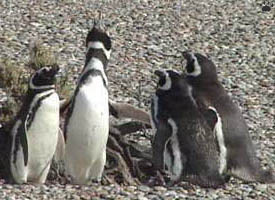
Two couples in a territorial dispute, San Julian. |
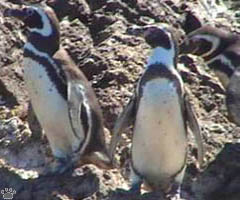
Humboldt penguin (S. humboldti, center) differs from
Magellanic penguins in having one dark breast band, not two.
It is a very rare winter visitor to Tierra del Fuego from
South America's western coast. Pinguineria Punihuil, Chile. |
Part 4: Other seabirds
Back to Part 2
Home
|